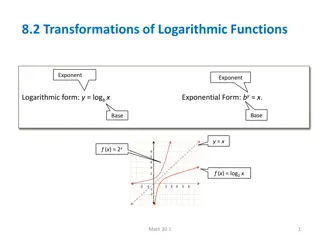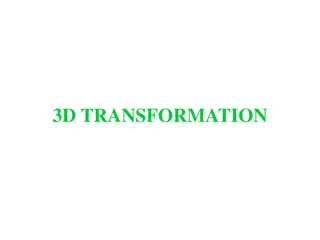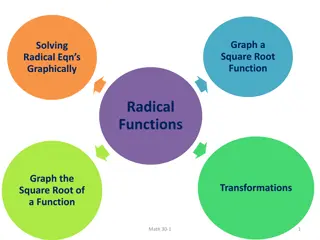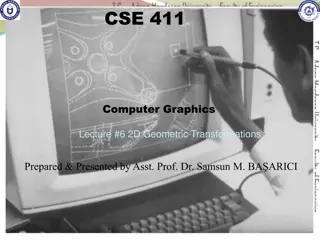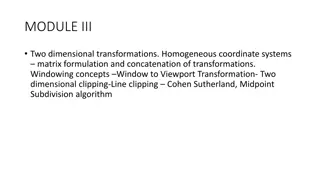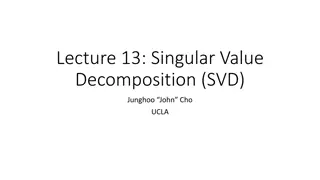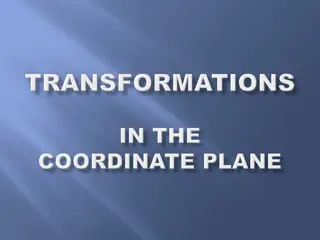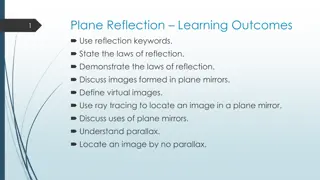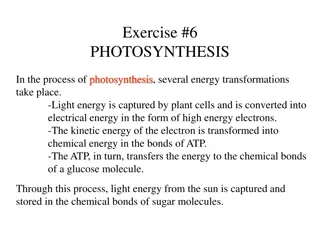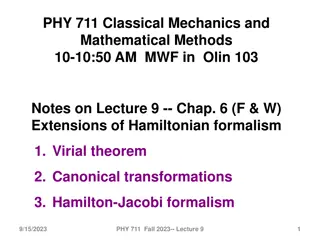Understanding Reflection in Transformations
A reflection in transformations involves flipping a figure over a given line of reflection, resulting in new prime points. This process is illustrated with examples and methods in a coordinate plane. Discover the principles of reflection and how to apply them effectively.
Download Presentation

Please find below an Image/Link to download the presentation.
The content on the website is provided AS IS for your information and personal use only. It may not be sold, licensed, or shared on other websites without obtaining consent from the author. Download presentation by click this link. If you encounter any issues during the download, it is possible that the publisher has removed the file from their server.
E N D
Presentation Transcript
Review: A TRANSFORMATION is . . . . . . . when a figure or point is moved to a new position in a coordinate plane. This move may include a change in size as well as position. A RIGID TRANSFORMATION is . . . . . . when the size and shape remain the same but the figure moves into a new position.
TRANSLATION(Slide) ROTATION . ..(Turn) REFLECTION ..(Flip) DILATION (Enlarges or Reduces)
Today we will work with REFLECTIONS Stop and do Reflection Activity Once ACTIVITY is complete, we will come back to the powerpoint and add to our notes.
REFLECTION is a movement of a figure that involves flipping the figure over the given line of reflection. The new prime points will be the same distance from the line of reflection as the original points but on the opposite side of the line of reflection which is the (line of symmetry).
EXAMPLE OF REFLECTION: Plot points A(3, 2), B(7, 2), and C(7, 6) then reflect the figure over the x axis and name your new prime points. A ( 3 , -2 ) Notice that each point is the same distance above and below the x axis B ( 7 , -2 ) C ( 7 , -6 ) The line that you are using to reflect over is called the LINE OF SYMMETRY
You have discovered that there are two methods to perform a REFLECTION . Each will give you the new prime points .
METHOD 1: From each point, conduct the move requested one point at a time and then draw in your new image. Example: Example: Plot points A(-2, 3), B(-6, 3), and C(-2, 7). Reflect the figure over the y axis. C C STEP 1: STEP 1: Plot original points B A B A STEP 2: STEP 2: From each original count the number of units from the y-axis and move the same distance on the opposite side of the y-axis STEP 4: Now list the location of the new points as your primes . STEP 3: STEP 3: Connect the new points. This is your image and the points are the prime points. A(-2,3) A (2, 3) B(-6,3) B (6, 3) C(-2,7) C (2, 7)
METHOD 2: A reflection will only affect the x-coordinate if reflecting over the y-axis and . . . will only affect the y-coordinate if reflecting over the x-axis.
Example 1: Example 1: Plot points A(-2, 3), B(-6, 3), and C(-2, 7) and reflect over the x-axis: A (-2, 3) reflected over the x-axis A (-2, -3) B (-6, 3) reflected over the x-axis B (-6, -3) C (-2, 7) reflected over the x-axis C (-2, -7) *NOTE that the x value stayed the same and the y value became its own opposite. Example 2: Example 2: Plot points A(-2, 3), B(-6, 3), and C(-2, 7) and reflect over the y-axis: A (-2, 3) reflected over the y-axis A (2, 3) B (-6, 3) reflected over the y-axis B (6, 3) C (-2, 7) reflected over the y-axis C (2, 7) *NOTE that the y value stayed the same and the x value became its own opposite.
When a pre-image is reflected over the x-axis, what happens to the coordinates? Over the y- axis? Are the pre-image and image congruent? Similar? How do you know? Use points A(-3, -5), B(-1, -2), and C(-1, -6) What would the coordinates of the image be if the figure was flipped over the x-axis? The y-axis?




